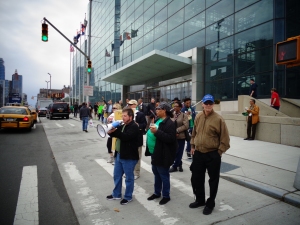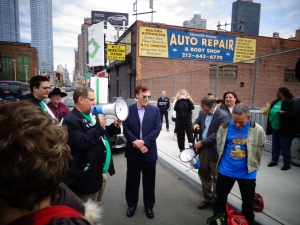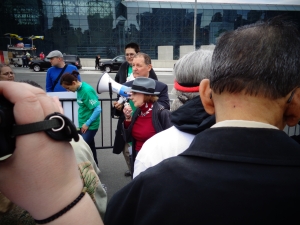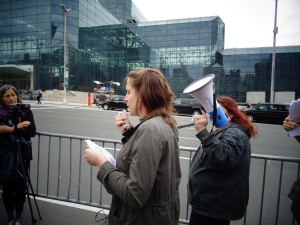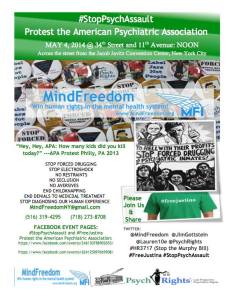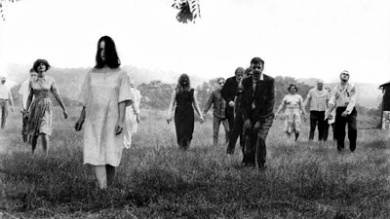The “mental illness” industry propaganda machine is running full throttle this month, especially in my neck of the swamp. All sorts of events have been planned, here in Gainesville Florida, for May, Mental Health Awareness Month, a 60 something designation originated by Mental Health America, at one point almost the lone voice for the mental health movement, a movement to get government to foot the bill for “mental illness”.
A local movie theater is showing Call Me Crazy, one of Hollywood’s most recent excursions into the area of “mental illness” propagandizing. There is also going to be a panel discussion, and a Mental Health Fair (sic), Apparently, given “campaigns against stigma”, there is no way in hell that “mental illness” can be allowed to keep a low profile. This is about selling nonsense, folks, and as it is being done all over the country, it is about selling nonsense big time.
Did I say big? “Mental illness” is big business. This is how it works. You’ve got a tin cup pitch being offered in unison for more funds to pay for it. It is psychiatric labeling, drugs, “mental health” workers and facilities. Education is particularly important. Education is corporate propaganda, in other words, advertising. The more educating you do, the more “mental illness” you get. The more “mental illness” you get, the better your chances of swindling the public into giving you more money.
Prevention is a joke at this point. Prevention is usually a matter of labeling and drugging children. Not getting ‘em early on is seen as “causative” because it is thought that delayed diagnosis increases severity. Problem. The kid who is not got is not “ill”. The severity of the label starts with the label itself. Not that long ago, in fact, childhood wasn’t a bona fide “mental illness”. Actual people, baby sitters and parents, tended the fledgling flock of humanity,. Now, more and more often, the child rearing task is being relegated to stimulants, sedatives, and happy pills, and I can’t say that they’ve been doing a terrific job of it.
We’ve got a “mental illness” epidemic raging throughout much of the world today, and no wonder. If gun violence erupts, “mental illness” did it. If people are poor and without permanent shelter, they must be “mentally ill”. “Mental illness” is our answer to social issues. It’s not a matter of flawed groups, it is a matter of flawed individuals. All we need to do is segregate, label, drug, and treat the offending parties responsible for any disagreement in groups, and voila, everything is hunky dory again.
Not so fast. The perfect son or daughter, who received the perfect grade, got the perfect job, and now runs the perfect major corporation are becoming more of a liability than our “diseased” failures ever were. Life on the planet earth is now threatened by our idea of wellness and success. Maybe we need to take a harder look at the potential in our throwaway populations of people. Perhaps there is something we missed, Perhaps they are not so totally tainted and ruined by “brain disease” after all.
You will never find a “mental illness” under a microscope lens. This is because “mental illness” is not a legitimate medical condition. There is nothing to find when what passes for symptoms are merely a checklist of aberrant behaviors. Although some psychiatrists would resolve the Cartesian mind body duality by declaring mind brain, I challenge anybody to find an identifiable thought or feeling in a synaptic cleft or a neural circuit. It will always elude them. Mental and physical are simply not synonymous.
The dilemma confronting us today is that standard psychiatric practice invariably involves physically damaging the patient. The propaganda is not propaganda favoring “mental health”. What is that? The propaganda is actually propaganda favoring physical injury. The way out of the psych-ward should not be through another department in the hospital, or the mortuary, but this is increasingly becoming the case. The only ‘other way’ involves seriously butting heads with the mental health establishment as “stigma” has been redefined to mean any disagreement with the propaganda.
Filed under: Advertising, Biological Psychiatry, Children and Adolescents, Commerse, Conflict of Interest, Discrimination, Disinformation, Education, Fraud, Mad Pride, Mental Health America, Mental Health Awareness Month, Mental Health Care, Misdiagnosis, Nanny State, Oppression, Pharmaceutical Company, Polypharmacy, Psychiatric Drugs, Violence | 3 Comments »


